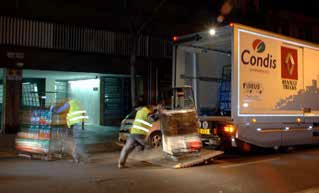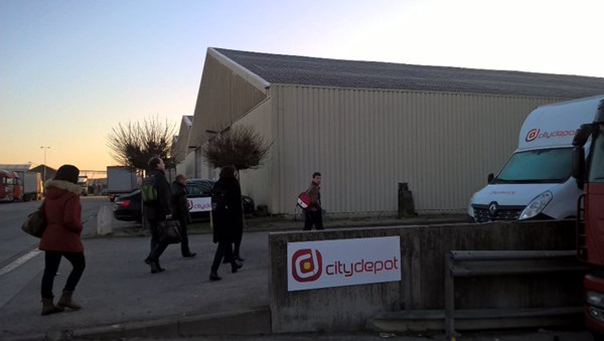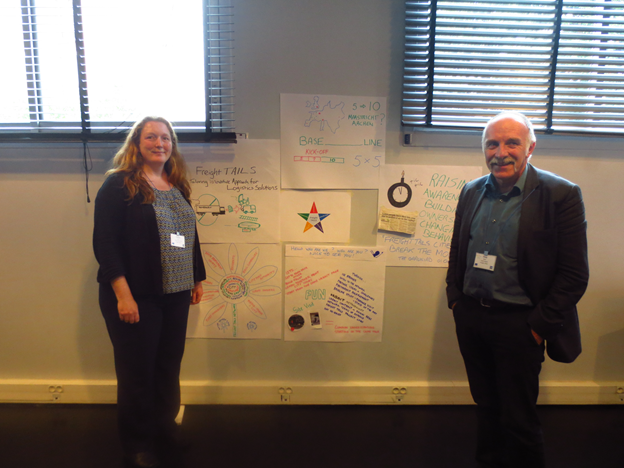Damaged (by) goods? The case for sustainable urban freight logistics
Edited on
26 April 2016Today I was woken up at 6am by a loud rattling noise. I looked through the window; two men were carrying crates of beer to the new bar downstairs. I tried to go back to sleep but half an hour later, my doorbell rang. “A package for Ms. Schneider!” Ms. Schneider lives upstairs from me and since her grandkids introduced her to the wonders of online shopping, the packages have been coming non-stop.
I leave the house sleepy and in a bad mood. It doesn’t help that I have to navigate my way through overflowing trash cans standing on the curb, weren’t they supposed to be emptied this morning? On the way to a bus stop, I stop by my favorite bakery. “Can I have a chocolate croissant, please?” “Sorry, they will not be delivered before 12 today” Seriously, who eats chocolate croissants for lunch?
I get on the bus and start reading a newspaper. “Food prices on the rise due to increased transport costs” Annoyed, I put the newspaper back in the bag and look through the window. A giant lorry exiting the construction site has totally blocked the road and I will most certainly be late. As I run to the office, I can hear the wheezing in my breath again. My asthma has gotten so much worse since I moved back to the city a few months ago!

Our wallets, lungs and nerves deserve better
According to the definition proposed by the CIVITAS Initiative, urban freight logistics concerns “all movements of goods in to, out from, through or within the urban area made by light or heavy vehicles, including also service transport and demolition traffic, as well as waste and reverse logistics”[i]. It is the critical life support system of the city that – as long as everything is working fine – remains almost invisible. It is probably not one of the issues that first come to mind when we think about the quality of life in urban areas and yet, as the story above illustrates, it has a direct impact on our wallets, lungs and nerves.
“Cities are places for the exchange of goods and information which are at the heart of our economy and way of life. For cities to be successful they need to optimise the exchange of goods and information while remaining attractive places to live and work.”[ii]
The estimates provided by the CIVITAS Initiative[iii] are helpful in grasping the sheer scale of freight movements in European cities. An average European city would see 300-400 vehicle trips per 100 inhabitants every single day, with 30-50 tons of goods per person being transported annually. Urban freight accounts for:
- 10-15% of kilometres travelled,
- 3-5% of urban land use (reserved for logistics activities), and
- 6% of all transport-related GHG emissions.
From an environmental policy perspective, cleaning up urban freight logistics is an important step towards achieving local and European goals, particularly with regard to air pollution, CO2 emissions and resource efficiency. If we add to this the economic importance of the sector plus its social impacts (such as e.g. noise or traffic safety), it becomes clear that cities need to get urban freight logistics right.

Source: Nightime deliveries, CIVITAS Policy Note, CIVITAS Initative 2015, p.22
Destination is clear but we are moving too slow
The European Commission strongly supports the shift towards sustainable urban freight logistics, not only through policy documents but also through related funding opportunities and research. The 2011 Transport White Paper set the goal of achieving essentially CO2-free city logistics in major urban centres by 2030[iv], encouraging the exchange of best practice, development of integrated strategies and improved public procurement procedures. The 2013 Urban Mobility Package proposed further actions to improve efficiency and reduce environmental impact of urban freight logistics, e.g. integration of urban logistics into Sustainable Urban Mobility Plans (SUMPs).
However, despite a clear policy direction and a number of possible measures identified, the implementation is lagging behind. The 2013 Commission Staff Working Document recognizes that “efficient urban logistics is essential for the economy and the quality of life in cities where most European citizens live but is largely neglected in urban transport policy and planning”, adding that “despite the general agreement on the problems, and in many cases the solutions, there is a broad lack of attention to urban logistics issues”[v]. The document identifies 3 major gaps to be addressed:
- lack of focus and strategy on urban logistics,
- lack of co-ordination of urban logistics actors,
- lack of data and information.
Compared to the mobility of people, the mobility of goods is an even more complex governance challenge. First of all, we are dealing here with multitude of actors: from multinational companies to local microentreprises, from invidual residents to large private and public sector institutions[vi]. Secondly, freight movements operate on different scales, from global to very local, often just passing by through a city in question. Lastly, the sector is not only an important economic player but also essential to the economic success of the city and its surroundings. Add to this the changing urban form, such as increased density in some areas and urban sprawl in others, plus growing popularity of online shopping (shopping might be online but deliveries are usually very real!) and you end up with an urban planner’s nightmare.
How to move forward with the much-needed implementation of sustainable urban logistics? The URBACT programme, with its focus on integrated strategies and stakeholder engagement, can offer a valuable contribution to the European community of planners and mobility experts.
Freight TAILS to the rescue

Freight TAILS (Tailored Approaches for Innovative Logistics Solutions) is an URBACT Action Planning Network dedicated to taking sustainable urban logistics one step further, exploring innovative freight solutions in various geographic, socio-economic and policy contexts. The network is a partnership of 9 local and regional authorities:
- City of Westminster – Cross River Partnership (London, UK)
- Brussels – Capital Region (Belgium)
- Municipality of Gdynia – ZDiZ Gdynia (Poland)
- La Rochelle Urban Community (France)
- Maastricht – Maastricht Bereikbaar (Netherlands)
- Comune di Parma (Italy)
- City of Split (Croatia)
- Suceava (Romania)
- City of Tallinn (Estonia)
- Umeå Kommun (Sweden)
Cities embark on this project to "review what is working and why to improve city logistic activity patterns, to identify obstacles and re-evaluate solutions, to explore real transferability, to focus on developing appropriate packages of complementary and jointly reinforcing measures"[vii]. Most of the partners have considerable experience in addressing urban freight issues, raising high expectations for what they can achieve together.
Sticks, carrots and strategic plans
European cities have long experimented with various measures designed to improve the efficiency and reduce the environmental impact of freight movements. The tricky part here is to find the balance between boosting economic gains and satisfying customer needs on one side, and safeguarding the environment and providing good quality of life on the other. Luckily, many of the measures tested can provide both economic and environmental benefits, e.g. urban consolidation centres, eco-driving programmes or real-time information systems.
 Source: "Smart choices for cities. Making urban freight logistics more sustainable”,
Source: "Smart choices for cities. Making urban freight logistics more sustainable”,
CIVITAS Policy Note, CIVITAS Iniative 2015
CIVITAS Initiative distinguishes between 6 types of measures[viii], ranging from market-based ones (e.g. tax incentives for clean vehicles) to regulatory ones (e.g. various types of access restrictions), from sticks to carrots, from low-hanging fruit to advanced schemes. However, the challenge is to find the right mix for a particular urban context and mobilise political leadership needed to secure implementation.
The 2013 Strategic plan for goods traffic[ix] in the Brussels-Capital region (one of the Freight TAILS partners) provides an interesting example of how to approach urban freight logistics in an integrated manner. The plan, developed with participation of various regional stakeholders, includes 36 actions organized in 5 priority areas that – if successfully implemented – will turn Brussels into a model for sustainable and efficient urban distribution of goods by 2050. The following priority areas have been included:
- organise the urban distribution structure, a framework allowing to group and transport goods more cleanly and efficiently;
- integrate urban distribution in regional land-use planning and development;
- quickly improve the efficiency of urban deliveries and reduce nuisances;
- encourage research and innovation and collect regional data;
- develop a regional framework favourable to an efficient, sustainable urban distribution.
Today goods traffic only represents 14% of the overall traffic in Brussels, even if that already translates to 16.000 lorries and 26.000 vans entering every day. However, with an 80% increase of merchandise flows expected by 2050, it is clear why Brussels-Capital Region is intent on addressing the issue before the city suffocates.
In preparing and implementing the plan, Bruxelles Mobilité – the public body responsible for its development, has been drawing heavily on best practices coming from cities across Europe and hopefully this spirit of collaboration will continue with the Freight TAILS project. The first transnational meeting that took place in Brussels in February 2016 was definitely a good indication, with all partners visiting Brussels’ Urban Consolidation Centre (UCC), operated by City Depot and discussing its business model.
The establishment of the UCC is a pilot project, with plans to create a multi-centre network across Brussels. The trial was implemented as part of the European project LaMiLo that aimed to improve the “last mile” in a logistics supply chain journey.

The Freight TAILS morning: visit to the Urban Consolidation Centre in Brussels. Source: Freight TAILS
5 questions to be answered by Freight TAILS
So where next for Freight TAILS cities? During the start-up phase of the project, the partners have identified 5 common challenges to be addressed by the network:
- how to overcome technical, economic and political factors limiting integrated freight management?
- how to encourage public sector, businesses and consumers to demand more sustainable freight services?
- how to use sustainable public procurement practices to stimulate the market, reduce costs and achieve better environmental outcomes?
- how to promote zero emission vehicles for fossil fuel free urban logistics?
- what kind of smart management solutions work best at the local level?

Source: Charlotte Knell (Lead Partner, Cross River Partnership, UK)
and Philipp Stein (Freight TAILS Lead Expert) representing the project during URBACT meeting in Paris. Source: Cross River Partnership
If these questions resonate with you, if you have good (or even better, bad) experiences you would like to share, please get in touch with the Freight TAILS network. You can follow @freight_tails on Twitter or get updates on their progress via the URBACT website.
[i] "Smart choices for cities. Making urban freight logistics more sustainable”, CIVITAS Policy Note, CIVITAS Initative 2015, accessed 7 April 2016, p.9
[ii] A call to action on urban logistics, SWD (2013) 524 final, Brussels 17.12.2013, accessed 8.04.2016, p.2
[iii] Smart choices for cities, p.7
[iv] Roadmap to a Single European Transport Area – Towards a competitive and resource-efficient transport system, COM (2011) 144 final, Brussels 28.03.2011, accessed 18.04.2016
[v] A call to action on urban logistics, SWD (2013) 524 final, Brussels 17.12.2013, accessed 8.04.2016, p. 9-10
[vi] See above "Smart choices for cities. Making urban freight logistics more sustainable", p.12 for a comprehensive overview of urban freight stakeholders
[viii] "Smart choices for cities. Making urban freight logistics more sustainable", p.16
[ix] Strategic plan for goods traffic in the Brussels-Capital Region, Bruxelles Mobilité 2014
 Submitted by Ania Rok on
Submitted by Ania Rok on




